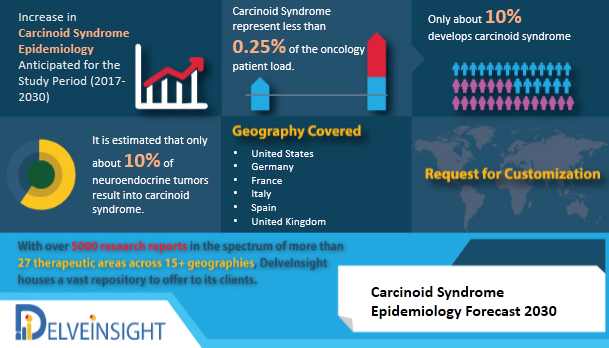DelveInsight has launched a new report on Carcinoid Syndrome Epidemiology
Carcinoid syndrome is the collection of symptoms some people get when a neuroendocrine tumor, usually one that has spread to the liver, releases hormones such as serotonin into the bloodstream. It is predominantly associated with neuroendocrine tumors (NETs) that arise from the mid-gut in the setting of extensive liver metastases but may be present in patients with bronchial carcinoids, and more rarely, in patients with pancreatic NETs.
Request for free sample copy- https://www.delveinsight.com/sample-request/carcinoid-syndrome-epidemiology-forecast
A Carcinoid Syndrome Epidemiology detailed review of historical and forecasted Carcinoid Syndrome market is included in the report, covering drug outreach in the G8 countries.
Carcinoid Syndrome Epidemiology
Carcinoid syndrome refers to a group of symptoms caused by the systemic release of different kinds of humoral factors like polypeptides, biogenic amines, and prostaglandins mostly from well-differentiated neuroendocrine tumors. Previously well-differentiated neuroendocrine tumors were known as carcinoid tumors. Neuroendocrine tumors are derived from enterochromaffin cells that are ubiquitous in our body. As per the study conducted by Alur et al. (2017), it is estimated that only about 10% of neuroendocrine tumors result into carcinoid syndrome. Carcinoid-syndrome is characterized by the presence during the disease at some time of diarrhea, cutaneous flushing, wheezing/asthma-like symptoms, and pellagra-like skin lesions with hyperkeratosis and pigmentation. In Canada, carcinoid tumors represent less than 0.25% of the oncology patient load.
Key facts of the Carcinoid Syndrome Epidemiology report
- The National Organization for Rare Disorders estimates that 27 new cases of Carcinoid Tumor per million are diagnosed in the United States per year out of which, only about 10% develops carcinoid syndrome.
- According to the study conducted by Pandit et al. titled “Carcinoid Syndrome”, flushing is the most common presentation and occurs in about 85% of patience with Carcinoid Syndrome and diarrhea occurs in about 80% of cases (Diarrhea is usually chronic in carcinoid syndrome).
- According to the study titled “Carcinoid syndrome” conducted by Rehman et al., in Japan, the rate of incidence of carcinoid tumors has increased from 1.09 cases per 100,000 in 1973 to 5.25 cases per 100,000 in 2004, with a median age at diagnosis of 63 years.
Carcinoid Syndrome Epidemiology Segmentation
- Total Incident Cases of Carcinoid Syndrome in the G8 [2017–2030]
- Gender-specific Incident Cases of Carcinoid Syndrome in the G8 [2017–2030]
- Symptom-specific Incident Cases of Carcinoid Syndrome in the G8 [2017–2030] ((Diarrhea, Flushing, Wheezing and others)
- Treatable Cases of Carcinoid Syndrome in the G8 [2017–2030]
Carcinoid Syndrome Prevalent Population
Carcinoid tumors have a low incidence rate of 1.9 per 100,000. The overall incidence appears to have increased since the early 1970s, which may at least partly reflect better diagnosis and awareness. However, in Ontario, the incidence rose from 2 per million in 1964 to 22 per million in 2002.
What will be the key Questions Answered?
- What will be the growth opportunities in the 7MM with respect to the patient population pertaining to Carcinoid Syndrome?
- What are the key findings pertaining to the Carcinoid Syndrome epidemiology across 7MM and which country will have the highest number of patients during the forecast period (2017-2030)?
- What would be the total number of patients of Carcinoid Syndrome across the 7MM during the forecast period (2017-2030)?
- Among the EU5 countries, which country will have the highest number of patients during the forecast period (2017-2030)?
- At what CAGR the patient population is expected to grow in 7MM during the forecast period (2017-2030)?
- What is the disease risk, burden and unmet needs of the Carcinoid Syndrome?
- What are the currently available treatments of Carcinoid Syndrome?
Request for free sample copy- https://www.delveinsight.com/sample-request/carcinoid-syndrome-epidemiology-forecast
Table of content
1. Key Insights
2. Executive Summary of Carcinoid Syndrome
3. Carcinoid Syndrome: Disease Background and Overview
4. Patient Journey
5. Epidemiology and Patient Population
6. Treatment Algorithm, Current Treatment, and Medical Practices
7. KOL Views
8. Unmet Needs
9. Appendix
10. DelveInsight Capabilities
11. Disclaimer
12. About DelveInsight
Reasons to buy
- Develop business strategies by understanding the trends shaping and driving the global Carcinoid Syndrome market
- Quantify patient populations in the global Carcinoid Syndrome market to improve product design, pricing, and launch plans
- Organize sales and marketing efforts by identifying the age groups and sex that present the best opportunities for Carcinoid Syndrome therapeutics in each of the markets covered
- Understand the magnitude of Carcinoid Syndrome population by its epidemiology
- The Carcinoid Syndrome Epidemiology Model developed by DelveInsight is easy to navigate, interactive with dashboards, and epidemiology based with transparent and consistent methodologies. Moreover, the model supports data presented in the report and showcases disease trends over 11-year forecast period using reputable sources
Related Reports
Media Contact
Company Name: DelveInsight Business Research LLP
Contact Person: Yash Bhardwaj
Email: Send Email
Phone: +919650213330
Address:304 S. Jones Blvd #2432
City: Las Vegas
State: NV
Country: United States
Website: https://www.delveinsight.com/

